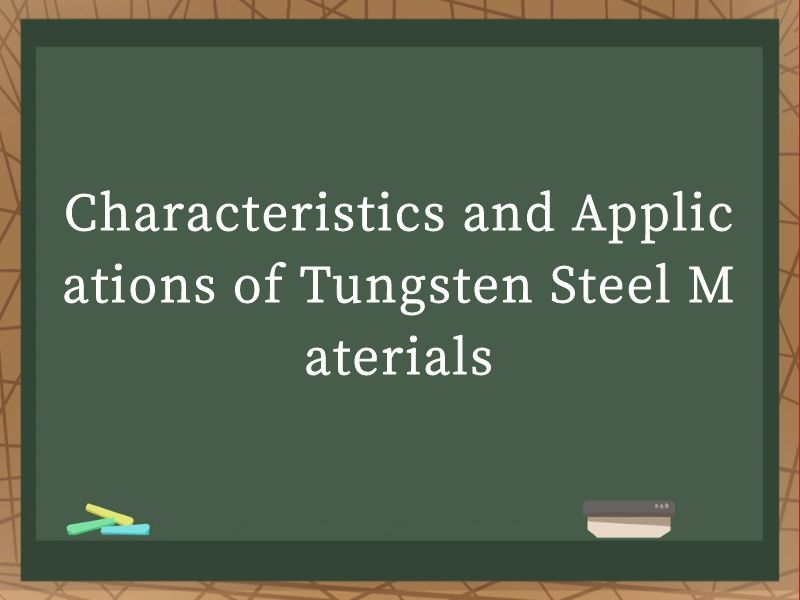JOURNALISM
- NEWS -
|
Characteristics and Applications of Tungsten Steel MaterialsCharacteristics and Applications of Tungsten Steel Materials.Tungsten steel, also known as high-speed steel, is a type of alloy steel that contains a significant amount of tungsten, along with other elements such as chromium, molybdenum, vanadium, and cobalt. This unique composition gives tungsten steel its exceptional hardness, wear resistance, and heat resistance, making it an indispensable material in various industrial applications. In this article, we will delve into the characteristics and applications of tungsten steel materials, highlighting their versatility and importance in modern technology.
Unique Properties of Tungsten Steel 1. Exceptional Hardness One of the most notable characteristics of tungsten steel is its exceptional hardness. This hardness is primarily attributed to the presence of tungsten carbide (WC) in its microstructure. Tungsten carbide is one of the hardest materials known, with a hardness that surpasses that of many other metals and alloys. This hardness makes tungsten steel ideal for applications where wear resistance and durability are paramount. 2. High Wear Resistance In addition to its hardness, tungsten steel exhibits high wear resistance. This means that it can withstand extensive friction and abrasion without significant degradation. This property is particularly important in tools and components that are subjected to continuous wear, such as cutting tools, drills, and dies. By maintaining their shape and integrity over extended periods, tungsten steel tools reduce the need for frequent replacement, thereby lowering operational costs. 3. Excellent Heat Resistance Tungsten steel's heat resistance is another key characteristic that sets it apart from other materials. It can maintain its hardness and mechanical properties at elevated temperatures, making it suitable for applications involving high-temperature environments. This heat resistance is crucial in industries such as metalworking, where tools must perform reliably under extreme conditions. 4. Good Toughness and Strength Despite its hardness, tungsten steel also possesses good toughness and strength. This combination of properties allows it to withstand both impact and compressive loads, making it suitable for applications where both wear resistance and structural integrity are required. For instance, in mining and construction, tungsten steel components can endure the rigors of heavy-duty operations without failing. 5. Machinability and Formability Despite its hardness, tungsten steel can be machined and formed into complex shapes and sizes. This machinability is achieved through the use of specialized tools and techniques that are designed to handle the material's unique properties. The ability to machine and form tungsten steel into various shapes and sizes expands its range of applications, allowing it to be used in components that require precision and complexity. Applications of Tungsten Steel Materials 1. Cutting Tools One of the most common applications of tungsten steel is in cutting tools. Due to its hardness and wear resistance, tungsten steel is ideal for making tools such as drills, milling cutters, and turning tools. These tools can cut through a wide range of materials, including metals, plastics, and composites, with minimal wear and tear. The use of tungsten steel cutting tools significantly improves productivity and reduces operational costs in manufacturing processes. 2. Dies and Molds Tungsten steel is also widely used in the production of dies and molds for metal forming and plastic injection molding. The hardness and wear resistance of tungsten steel ensure that dies and molds maintain their shape and integrity over extended periods, producing high-quality parts with consistent dimensions and finishes. This makes tungsten steel an essential material in the automotive, electronics, and consumer goods industries, where precision and reliability are critical. 3. Mining and Construction Equipment In the mining and construction industries, tungsten steel is used to manufacture components that are subjected to extreme wear and tear. Examples include drill bits, crusher jaws, and wear plates. The hardness and toughness of tungsten steel allow these components to endure the rigors of heavy-duty operations, reducing the need for frequent replacement and lowering maintenance costs. 4. Aerospace and Defense Tungsten steel's heat resistance and mechanical properties make it an ideal material for use in aerospace and defense applications. Components such as engine parts, missile casings, and armor plating often require materials that can withstand high temperatures and extreme loads. Tungsten steel meets these requirements, providing the necessary durability and reliability in critical applications. 5. Medical Instruments In the medical field, tungsten steel is used to manufacture instruments that require precision and durability. Surgical tools, dental drills, and other medical devices benefit from tungsten steel's hardness and wear resistance, ensuring that they perform reliably and safely during medical procedures. The ability to machine tungsten steel into complex shapes and sizes also allows for the creation of specialized medical instruments that meet specific clinical needs. 6. Energy and Power Generation Tungsten steel plays a role in the energy and power generation industries, particularly in components that are exposed to high temperatures and pressures. For instance, turbine blades and valves in steam turbines and gas turbines often utilize tungsten steel to maintain their structural integrity and performance under extreme conditions. Additionally, tungsten steel is used in nuclear reactors for components that require radiation resistance and high-temperature stability. 7. Automotive Industry The automotive industry also benefits from the use of tungsten steel. Components such as gearbox parts, brake systems, and engine valves often incorporate tungsten steel due to its hardness, wear resistance, and heat resistance. These properties help ensure the reliability and durability of automotive components, reducing the likelihood of failures and extending the lifespan of vehicles. 8. Electronics and Semiconductor Manufacturing In the electronics and semiconductor manufacturing industries, tungsten steel is used in tools and components that require precision and accuracy. For instance, tungsten steel is used to make dies for wire bonding and wafer dicing, as well as in other processes that involve micro-machining and etching. The hardness and machinability of tungsten steel make it an ideal material for these applications, enabling the production of high-quality electronic components and devices. Future Trends and Developments As technology continues to advance, the demand for tungsten steel materials is likely to increase. Emerging industries such as renewable energy, robotics, and additive manufacturing are driving the development of new applications for tungsten steel. Researchers are continuously exploring ways to improve the material's properties, such as through alloying with other elements or applying surface treatments to enhance wear resistance and corrosion resistance. Additionally, there is a growing interest in the recycling and reuse of tungsten steel materials. As the global community becomes more aware of the environmental impact of waste, efforts are being made to develop efficient recycling processes for tungsten steel components. This not only reduces waste but also conserves natural resources and lowers production costs. In conclusion, tungsten steel materials offer a unique combination of properties that make them ideal for a wide range of applications. Their hardness, wear resistance, heat resistance, and machinability make them indispensable in industries such as metalworking, mining, construction, aerospace, and medical. As technology continues to evolve, the demand for tungsten steel is likely to grow, driving the development of new applications and innovations. With ongoing research and development, tungsten steel will continue to play a critical role in shaping the future of modern technology. |


